
Hyacinthoides is a genus of flowering plants in the family Asparagaceae, known as bluebells.
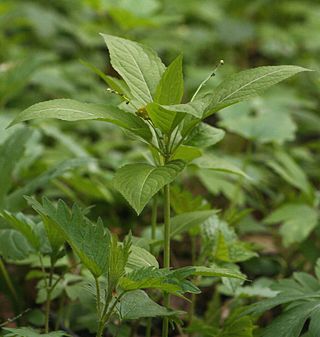
Mercurialis is a genus of plants in the family Euphorbiaceae, the spurges, known commonly as the mercuries. These are slender herbs (forbs), rhizomatious perennials and woody perennials, native to Europe, North Africa, and Asia.
- Mercurialis annuaL. – most of Europe, North Africa, the Middle East, and islands of the eastern Atlantic
- Mercurialis canariensisObbard & S.A.Harris – Canary Islands
- Mercurialis corsicaCoss. & Kralik – Corsica, Sardinia
- Mercurialis ellipticaLam. – Spain, Portugal, Morocco
- Mercurialis huetiiHanry – Spain, France, Morocco
- Mercurialis leiocarpaSiebold & Zucc. – China, Japan, Korea, Ryukyu Islands, Thailand, Assam, Bhutan, Nepal
- Mercurialis × longifoliaLam. – Spain, Portugal, France (M. annua × M. tomentosa)
- Mercurialis ovataSternb. & Hoppe – C + E Europe and SW Asia from Germany + Italy to Russia + Syria
- Mercurialis × paxiiGraebn. – C + E Europe from Germany to Crimea (M. ovata × M. perennis)
- Mercurialis perennisL. – most of Europe plus Algeria, Caucasus, Turkey, Iran
- Mercurialis reverchoniiRouy – Spain, Morocco
- Mercurialis tomentosaL. – Spain, Portugal, France, Balearic Islands
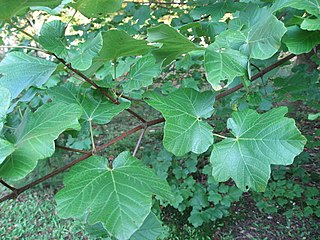
Acer opalus, the Italian maple, is a species of maple native to the hills and mountains of southern and western Europe, from Italy to Spain and north to southern Germany, and also in northwest Africa in Morocco and Algeria.
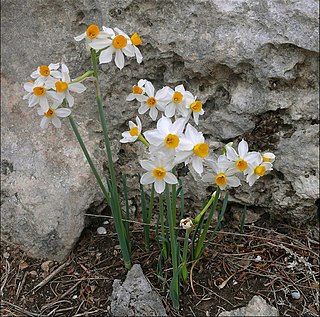
Narcissus tazetta is a perennial ornamental plant that grows from a bulb. Cultivars of N. tazetta include 'Paperwhite', 'Grand Soleil d'Or' and 'Ziva', which are popularly used for forcing indoors, as is the form of N. tazetta known as Chinese Sacred Lily.

Santolina chamaecyparissus, known as cotton lavender or lavender-cotton, is a species of flowering plant in the family Asteraceae, native to the western and central Mediterranean.

Dicoma is a genus of flowering plants in the family Asteraceae, native to Africa and the Middle East.

Romulea is a genus of flowering plants in the family Iridaceae, first described as a genus in 1772. It is distributed in Europe, the Mediterranean, the Arabian Peninsula, and Africa.

Simethis is a genus of plants in the family Asphodelaceae, subfamily Hemerocallidoideae. It contains only one known species, Simethis mattiazzii, commonly called the Kerry lily.

Dactylorhiza elata, the robust marsh orchid, is a species of flowering plant in the family Orchidaceae, native to the western Mediterranean region.
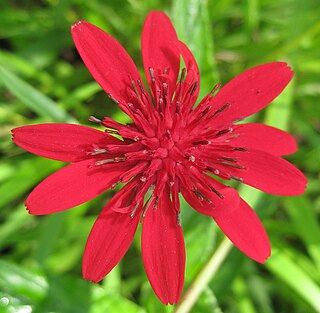
Erythrocephalum is a genus of African flowering plants in the family Asteraceae.

Coleostephus is a genus of flowering plants in the family Asteraceae.
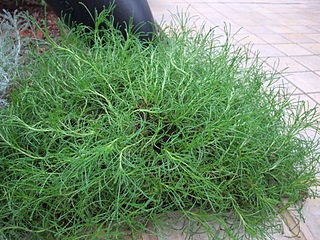
Santolina rosmarinifolia, the holy flax, is a species of flowering plant in the daisy family Asteraceae, native to south western Europe. It is a dense, compact evergreen shrub growing to 60 cm (24 in) tall and wide, with narrow, aromatic green leaves and tight yellow composite flowerheads carried on slender stalks above the foliage, in summer.
Hyacinthoides paivae is a species of bluebell in the genus Hyacinthoides native to the north-western part of the Iberian Peninsula. It lives chiefly in shady woodlands, and grows up to 45 cm (18 in) tall, producing a cluster of up to 18 pale blue flowers in spring. It was formally described in 1996, having previously been identified as belonging to the related species H. italica.

Cochylimorpha peucedana is a species of moth of the family Tortricidae. It is found in France, Spain and Portugal, as well as on Sicily, Corsica and Sardinia.
Bucculatrix santolinella is a moth in the family Bucculatricidae. It was described by Thomas de Grey, 6th Baron Walsingham in 1898. It is found in southern France and Spain and on Corsica and Sardinia.
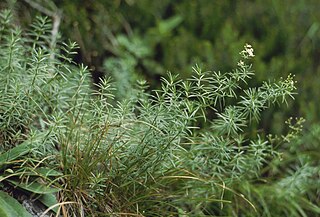
Galium lucidum is a species of plants in the Rubiaceae. It is native to the Mediterranean region, from Portugal and Morocco to Greece, the range extending northwards into Germany.

Cerastium diffusum, the fourstamen chickweed or sea mouse-ear, is a species of flowering plant in the pink and carnation family Caryophyllaceae. It is an annual herb, to 30 cm.high, occurring in western Europe and northern Africa. Found mainly in coastal areas of Algeria, the Baleares, Belgium, Corsica, Denmark, France, the Faroe Islands, Germany, Great Britain, Ireland, Italy, Libya, Morocco, Netherlands, Norway, Portugal, Sardinia, Sicily, Spain and Sweden. The flowers have 4, petals, 4 or 5 stamens appearing between March and May. The petals are much shorter than the sepals. The leaves are opposite, (sessile) without petioles and the sepals and bracts are all green, without pale margins. The fruit petioles are erect and diffuse at maturity.

Salix pedicellata is a species of willow. It is a shrub or small tree to about 6–8 m tall, native around the Mediterranean Sea from Portugal to Lebanon and Syria in the north and from the Canary Islands to Tunisia in the south. Salix canariensis may be treated as a subspecies of S. pedicellata.

Hormathophylla is a genus of flowering plants in the family Brassicaceae, native to the western Mediterranean; Morocco, Algeria, Spain, France and Italy. Perennial shrubs, they are adapted to dry, alkaline soils with high levels of magnesium.

Santolina virens, the green lavender cotton, is a species of flowering plant in the family Asteraceae, native to Spain, France, Great Britain, Germany, Italy, Ukraine, and the North Caucasus. This taxon has been marked by taxonomic difficulties since Linnaeus and is currently considered part of the Santolina chamaecyparissus species complex.


















